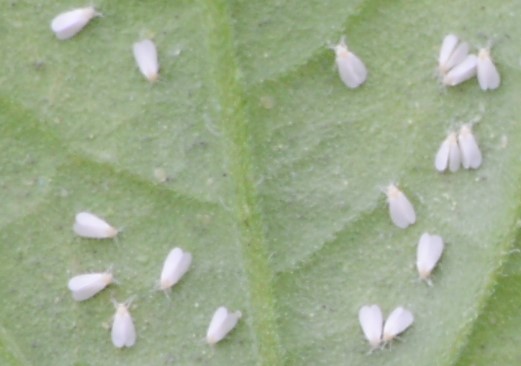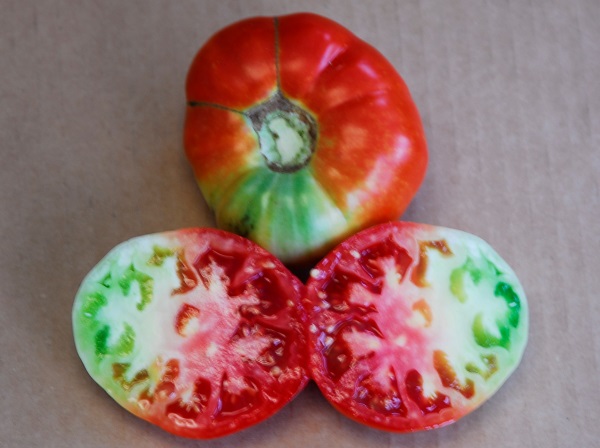Silverleaf Whitefly on Tomato
ENTFACT-320: Silverleaf Whitefly on Tomato | Download PDF
Ric Bessin, Extension Specialist
University of Kentucky College of Agriculture
Whitefly problems have been a common occurrence on tomatoes grown in the greenhouse, but with the arrival of silverleaf whitefly to Kentucky, problems in the field have emerged. Silverleaf whitefly, Bemisia argentifolli, is a relatively new pest to Kentucky. Although they have been a problem for growers in southern regions of the U.S. for several years, outbreaks in Kentucky had been relatively uncommon. Problems were observed during the dry hot summer of 2007 on heirloom varieties.
Silverleaf whitefly is a common pest of greenhouse plants throughout the year and, in the past, has been a relatively uncommon pest of cultivated plants in the field in Kentucky. Because it is unable to overwinter in Kentucky, it is more likely to be a problem of plants in greenhouses, high tunnels, on transplants shipped from southern regions, or in the field in mid-summer and fall. Hot, dry weather during the summer can favor rapid buildup of the silverleaf whitefly on wild and cultivated hosts outside of the greenhouse.

Figure 1. Silverleaf Whitefly.
Though silverleaf whitefly and its close relative, the greenhouse whitefly, are both small (about 1/8th inch) and similar in appearance there are some key differences. Silverleaf Whiteflies tend to have more yellowish body and position their wings closer to the sides of their bodies whereas the more common greenhouse whiteflies are generally paler in color and tend to hold their wings flat on their backs. Typically, the wings of the silverleaf whitefly do not touch such that a small portion of the yellow abdomen is visible between the wings.
Silverleaf whitefly cannot overwinter in Kentucky because they are unable to survive the freezing temperatures that occur here. However, they can survive in greenhouses and are commonly introduced on transplants produced in warmer regions of the U.S. They have a very wide range of hosts including: tomato, pepper, squash, bean, lettuce, eggplant, broccoli, cabbage, potato and watermelon.

Figure 2. Silverleaf whitefly may cause uneven ripening with some tomato varieties.
Effect on Tomato
While the effects of silverleaf whitefly can be easily seen on leaves the of squash plants, the fruit is the only known portion of the tomato plant that displays symptoms of the silverleaf whitefly-injury. When the silverleaf whiteflies feed on tomato plants they inject toxins into the plant which cause irregular ripening of the tomato fruit. Mature green fruit appear normal, as symptoms are not displayed until ripening. Symptoms typically appear on the outside of the tomato as a green or yellow areas appearing in a longitudinal pattern that fail to ripen. The unripe area extends fairly deep into the fruit. Although some tomatoes that are affected will appear to eventually ripen, the inside of the fruit will remain green in color.
Keep in mind however that there are many other ripening disorders in tomato fruit that have a variety of causes. Blotchy ripening and stink bug injury appears as scattered areas of the fruit that fail to ripen. Yellow shoulder disorder appears as a distinct yellow area on the shoulders of tomatoes that fails to ripen. These disorders may be the result of excessive heat, nutrient imbalance, soil moisture deficits or other pest problems. Some varieties are also more likely to be affected than others.
Management
Unfortunately, small numbers of silverleaf whitefly can cause fruit ripening disorders on some tomato varieties. However, once the whiteflies are controlled, the new fruit should ripen normally. Fruit damage on smaller plants maybe more severe than that to more mature plants.
There are a number of predaceous insects that feed on silverleaf whitefly and one commercial parasitoid wasp, Eretmocerus emericus, that has been used successfully in greenhouses.
Chemical control of whiteflies can be difficult as the adults and immature stage occur on the undersides of leaves, particularly older leaves, making spray coverage difficult. Insecticides listed for whitefly control in https://publications.ca.uky.edu/files/ID36.pdf, can be effective against silverleaf whitefly.
Issued: 11/19
CAUTION! Pesticide recommendations in this publication are registered for use in Kentucky, USA ONLY! The use of some products may not be legal in your state or country. Please check with your local county agent or regulatory official before using any pesticide mentioned in this publication.
Of course, ALWAYS READ AND FOLLOW LABEL DIRECTIONS FOR SAFE USE OF ANY PESTICIDE!
Photos courtesy Ric Bessin, University of Kentucky Entomology
